![Untitled design [Alt text] Sobre una pared amarilla hay un empapelado en blanco y negro de rostros de personas desaparecidas durante el Conflicto Armado Interno en Guatemala, sobre estos la imagen de Monseñor Gerardi en blanco y negro, socializado hombre con lentes y con su mano sosteniendo su mandibula. Sobre él, un arco de claveles en color rojo y la frase en letras blancas y amarillas: “Gerardi Vive”. [Alt text] On a yellow wall there is a black and white wallpaper of faces of people who disappeared during the Internal Armed Conflict in Guatemala, on these the image of Monsignor Gerardi in black and white, socialized man with glasses and with his hand holding his jaw. Above him, an arch of carnations in red and the phrase in white and yellow letters: "Gerardi Vive".](https://nisgua.org/wp-content/uploads/Untitled-design-1024x1024.png)
On April 26th, relatives of victims disappeared during the Internal Armed Conflict, honor the legacy of Monsignor Juan José Geradi Conedera. 25 years after his murder, his voice is still alive among the People, called to continue the struggles to vindicate memory, truth and justice in Guatemala.
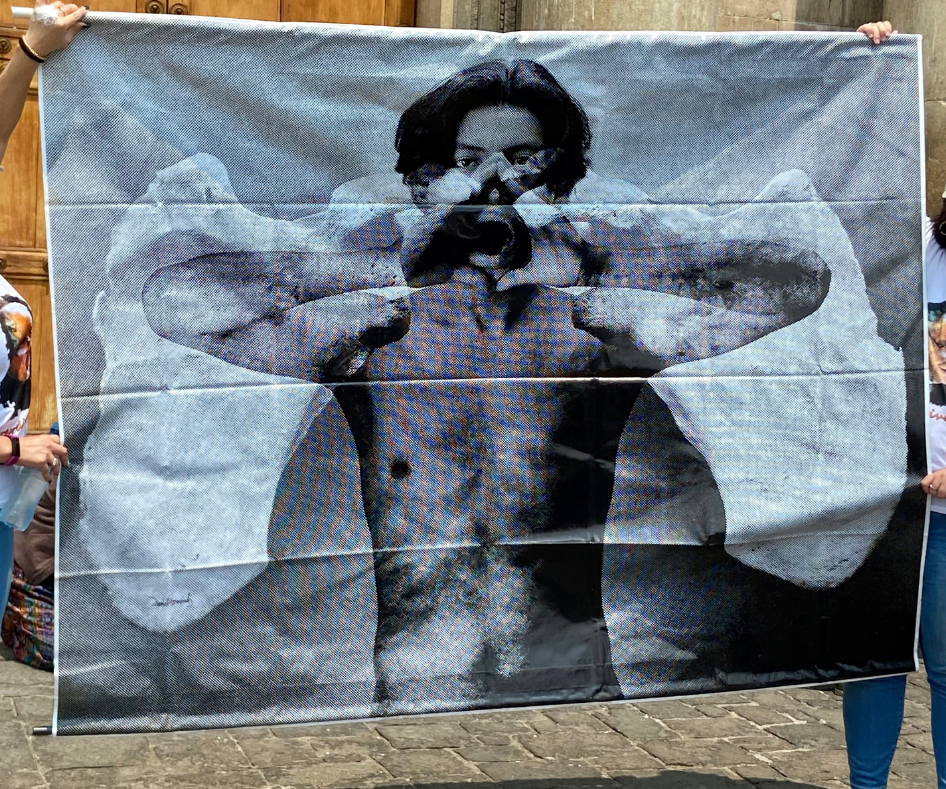
We invite you to know the path of solidarity that Monsignor Gerardi traced, may his testimony inspire us to continue accompanying the voices of the Peoples who struggle towards a different Guatemala, where the crimes of the past are not repeated.
![signal-2023-04-26-171925_010 [ESP] En el atrio de una iglesia, con muros cafes, paradas varias personas con carteles formando la palabra: "Guatemala Nunca Más". [ENG] n the atrium of a church, with brown walls, stood several people holding signs with the words: "Guatemala Nunca Más" (Guatemala Never Again).](https://nisgua.org/wp-content/uploads/signal-2023-04-26-171925_010-1024x1024.jpeg)
The Metropolitan Cathedral of Guatemala was the meeting point for hundreds of people to honor the life and legacy of Monsignor Juan José Gerardi Comedera. Ordained a priest in 1946 in Guatemala City, he carried his vocation to priestly service and social justice.
A Mass was celebrated in which the Archbishop invited to: “Keep alive the testimony towards a different Guatemala, where the wounds of impunity, inequality, injustice and violence are healed and that Gerardi’s example summons us to walk with our own light and truth in the midst of social and political difficulties and uncertainties.”
![Monseñor Gerardi (3) [ESP] En el atrio de la iglesia, varias personas socializadas hombres sostienen una pancarta con fondo blanco y borde rojo con el rostro de Mons Gerardi, se lee en color rojo la palabra: "gracias". Una de las persona que sostiene el banner porta una cruz pequeña de madera y flores amarillas y blancas. [ENG] In the atrium of the church, several socialized men hold a banner with a white background and red border with the face of Bishop Gerardi, the word "thank you" is read in red. One of the people holding the banner carries a small wooden cross and yellow and white flowers.](https://nisgua.org/wp-content/uploads/Monsenor-Gerardi-3-e1683218909855-1024x750.png)
With flowers, messages of gratitude for his struggle for the dignity of the Peoples, chants towards the search to vindicate the current injustices, corruption and impunity in Guatemala, the march from the Metropolitan Cathedral ended at the San Sebastian Parish, the place that was home of Monsignor Gerardi, until his assassination there on April 26, 1998.
“Today families of victims of the Internal Armed Conflict, interreligious sector, men and women, young people, adults and children we gather to commemorate this anniversary, to honor the life and legacy of Juan José Gerardi Comedera is fulfilled in the search for truth, justice and the construction of a different Guatemala, in peace and with social justice. The legacy of Monsignor Juan José Gerardi Comedera calls us, today in a context of accelerated repression and political persecution of just people, to join the example of Monsignor to shout the truth, to unmask the repressive power, the violence, which does not allow communities throughout the country to organize and to get out of the problems that we face every day”.
![signal-2023-04-26-171843_020 [ESP] En medio de una calle hay dos personas socializadas como hombres con camisetas blancas, ambos con gorras blancas, cargan cada uno tomado por el extremo, un banner color beige, en la parte de abajo del banner seis imagenes del rostro de una persona socializada hombre en tonos rojos y letras del mismo tono ilegibles. [ENG] In the middle of a street there are two people socialized as men in white T-shirts, both wearing white caps, each carrying a beige banner, on the bottom of the banner six images of the face of a male socialized person in red tones and illegible letters of the same tone.](https://nisgua.org/wp-content/uploads/signal-2023-04-26-171843_020-e1683219615167-865x1024.jpeg)
During the period of the Internal Armed Conflict, Juan José Gerardi raised his voice about persecutions of communities, catechists, priests. Currently, criminalization, persecution, imprisonment and assassinations continue to be the strategy used by the extreme right to silence defenders of territory, justice and life. The collusion of capital and colonial interests, at all levels within the Guatemalan State, puts at serious risk the possibility of obtaining justice for the crimes against humanity that occurred during the Internal Armed Conflict and today.
![Monseñor Gerardi (4) [ESP] Una persona socializada hombre deespaldas, con camiseta blanca que dice en letras anaranjadas: "Guatemla Nunca Más" con sombrero cafe y una malet verde através de su cuerpo, alza flores amarillas y blancas. [ESP] A socialized man with his back turned, wearing a white T-shirt that says in orange letters: "Guatemala Nunca Más" (Guatemala Never Again) with a brown hat and a green suitcase across his body, holds up yellow and white flowers.](https://nisgua.org/wp-content/uploads/Monsenor-Gerardi-4-e1683220163695-789x1024.png)
Gerardi was Archbishop in the Verapaces and Santa Cruz del Quiché, where he raised his voice against the violence that the populations of the indigenous communities lived, how access to education, health, land, among others; he promoted the Indigenous Pastoral whose development was diminished by the earthquake of 1976 and the CAI.
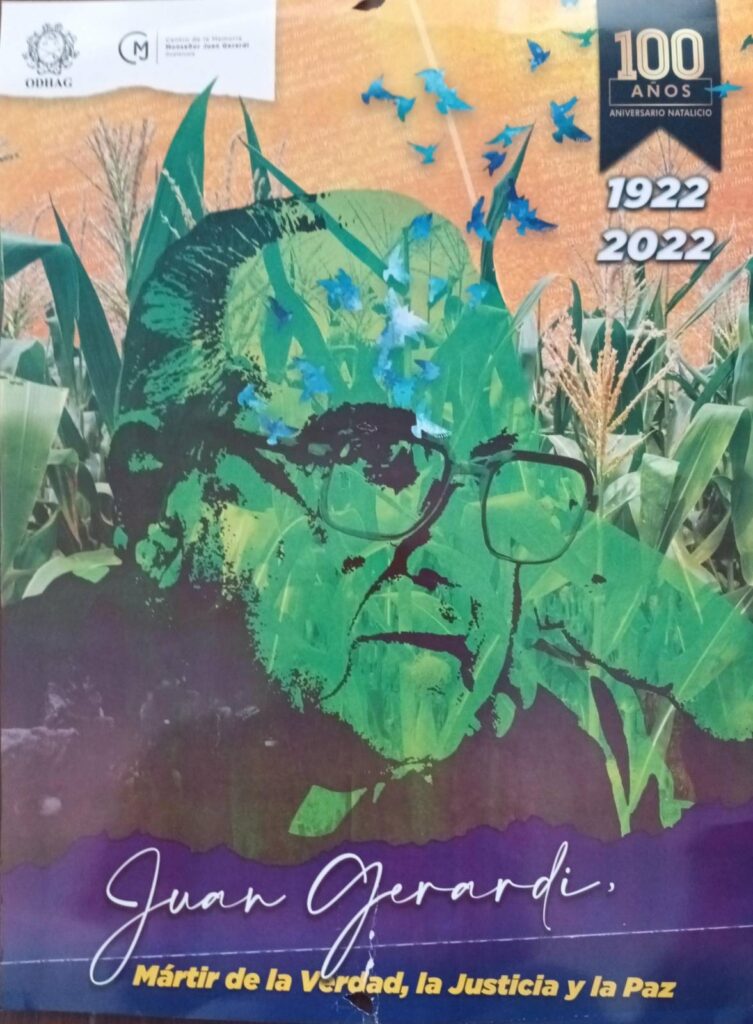
For two years he was exiled in Costa Rica, after an attempt on his life in 1980. We honor the struggle of defenders who, with arbitrary and illegitimate State tactics, have been harassed, slandered, arrested and forced into exile in order to impede their work towards a dignified and just Guatemala.
“Collective historical memory tells us that whoever resists the violent political and economic systems of the moment will become the target of attacks. But it also reminds us that, despite criminalization, the people always fight for collective justice.”
Source: NISGUA R113:Targets of the State: Dignit,justice, and criminalization in Guatemala. September 2022
![signal-2023-04-26-171925_028 [ESP] En un costado del atrio, frente a una imagen de un santo de la iglesia católica, sobre una alfombra de aserrin multicolor dos cuadros, el del lado izquierdo de monseñor Gerardi, socilizdo hombre cabello corto oscuro y del lado derecho la imagen de un Arzobispo con vestimenta formal, socializado hombre de cabello blanco. [ENG] On one side of the atrium, in front of an image of a saint of the catholic church, on a multicolored sawdust carpet two pictures, on the left side of Monsignor Gerardi, ancillary man with short dark hair and on the right side the image of an Archbishop in formal dress, a socialized man with white hair.](https://nisgua.org/wp-content/uploads/signal-2023-04-26-171925_028-1024x1024.jpeg)
One of its greatest legacies to the Peoples of Guatemala was the Recovery of Historical Memory Project (REMHI), it had the collaboration of more than 600s pastoral agents and 6,494 testimonies of victims of the CAI were collected, with which the history was reconstructed from the voices of victims, explaining the causes, consequences and those responsible for the IAC, which gave support to the report: “Guatemala Never Again.”

REMHI for the victims and relatives is the public recognition of the events that occurred during the CAI, a vindication of the truth of their word that had been denied for many years.
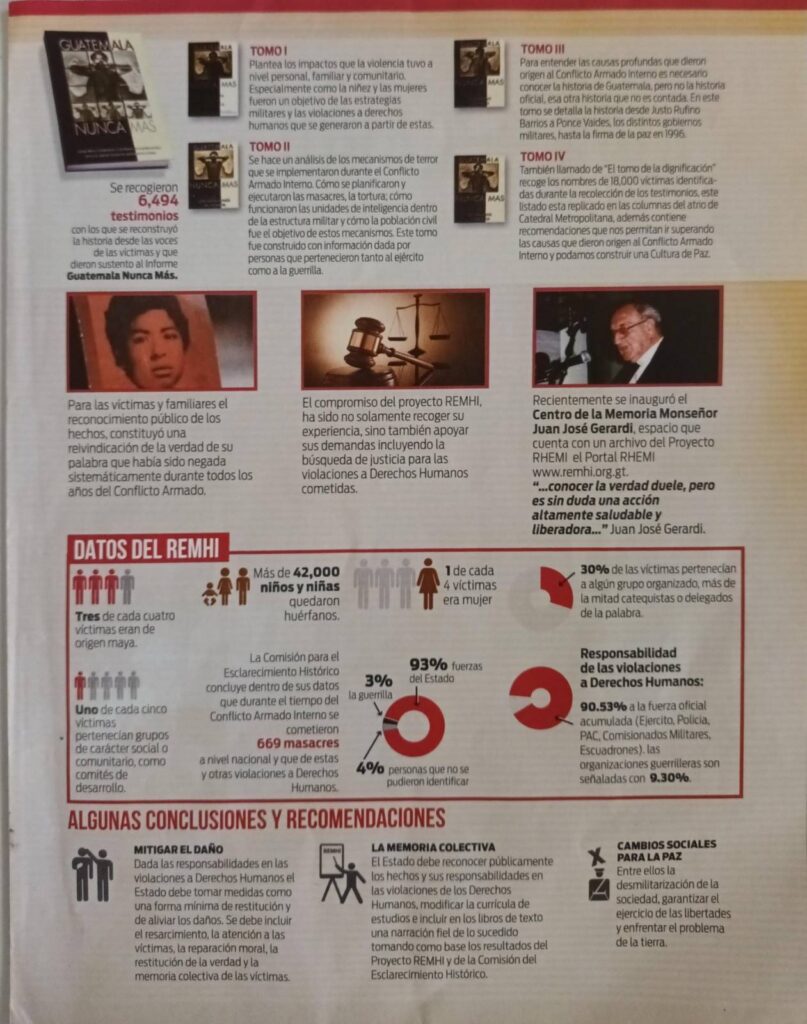
REMHI has also been the support of demands for the search for justice for the Human Rights violations committed, as for example for the two sentences in Guatemalan courts in which the existence of Genocide in Guatemala is recognized.
In a context of setbacks to justice, censorship and criminalization of the voices that rise for a different Guatemala, a Guatemala with social justice, it is important to bring to the present his legacy: “Knowing the truth, even if it hurts is necessary to heal wounds and build another future, 25 years later the memory and the work of Gerardi shed light to know our past and illuminate our future”.
The memory and legacy of Monsignor Gerardi continues in the hearts of his people.
Sources:
- The photographs, videos and audios were taken during the activity: 25th anniversary of the martyrdom of Monsignor Gerardi and the report: Guatemala Nunca Más, held on April 26, 2023 by the Guatemalan Archbishop’s Office of Human Rights and the Monseñor Juan Gerardi Memory Center.
- Newsletter: Life and work of Monsignor Juan Gerardi, martyr for truth and justice. April 2018. Guatemalan Archbishop’s Office of Human Rights and the Monseñor Juan Gerardi Memory Center.

![[ESP] En una iglesia de paredes blancas con pilares en formas de arcos, varias personas con la mirada hacia el altar. [ENG] In a white-walled church with arched pillars, several people gaze at the altar.](https://nisgua.org/wp-content/uploads/Monsenor-Gerardi.png)
![[ESP] La espada de dos personas con camiseta blanca, socializadas como hobres, en su camiseta con letras naranjas se lee: "Guatemala Nunca Más". Frente a ellos, de manera borrosa se distingue un cuadro con la imagen de Monseñor Gerardi. [ENG] The sword of two people in white T-shirts, socialized as hobres, on their T-shirt with orange letters reads: "Guatemala Nunca Más" (Guatemala Never Again). In front of them, a picture with the image of Monsignor Gerardi is blurred.](https://nisgua.org/wp-content/uploads/signal-2023-04-26-171925_033.jpeg)
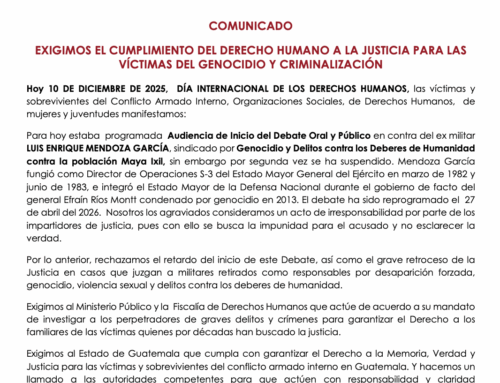
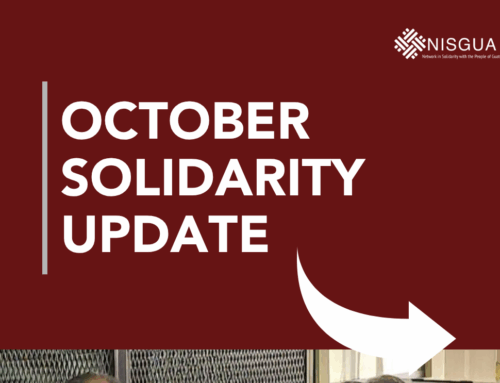
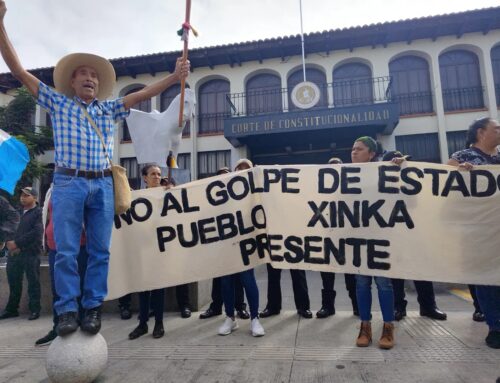
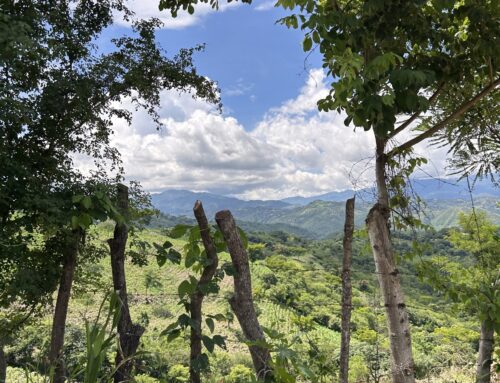
Leave A Comment